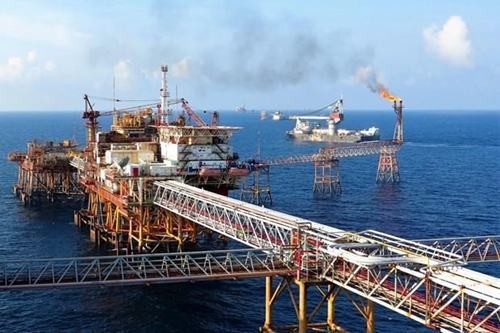Petrovietnam currently provides most of the key products of the economy as input materials for many other manufacturing sectors.
However, the “dual crisis” has hit the industry hard. According to reports of Petrovietnam subsidiaries, the key projects on exploration and production are currently affected by COVID-19. Many contractors will not be able to mobilize manpower to carry out the work on projects, while the supply of materials and equipment to those projects from the pandemic-hit countries under blockade and quarantine is also interrupted or delayed.
Worse still, petrol stations and agents are restricting imports to wait for price plunge and discount increase of retail price in the market compared to January 2020, thus seriously affecting the products of Dung Quat and Nghi Son refineries in the central provinces of Quang Ngai and Thanh Hoa, respectively.
    |
 |
|
In the January-April period, PetroVietnam produces 7.2 million tonnes of oil, exceeding the four-month plan by 7.7 percent. |
In the first months of this year, although the output of most fertilizer products of Petrovietnam's plants reached and exceeded the monthly plans, the consumption of urea and NPK fertilizer did not come up to expectation because demand was still low in most areas of agricultural production.
In terms of oil and gas technical services, similar difficulties were encountered as investors and contractors tended to cut and optimize production costs. In the immediate future, the COVID-19 pandemic will cause a sharp drop in the international freight rates for all vessel sizes. The sharp drop in oil prices will also affect the price of drilling rigs as when re-signing the contracts, the users will request re-negotiations of prices.
When the consumption of petrochemical products and the efficiency of oil and gas production decrease sharply, the revenue from oil sale and contribution to the State budget from crude oil will also drop dramatically as compared to the planned price of 60 USD per barrel.
Specifically, if the oil price is at 60 USD per barrel, revenue from selling crude oil is 4.668 billion USD. But if it drops to 30 USD per barrel, the revenue is only 2.362 billion USD. The contribution to the State budget will fall from 1.594 billion USD to 806 million USD. Correspondingly, Petrovietnam has lost 2.3 billion USD in revenue and nearly 800 million USD contributed to the State budget.
Perceiving that difficulties and challenges are considerable, during the recent past, with the motto of “Managing fluctuations, optimizing values, promoting consumption, striving to overcome difficulties, seizing opportunities and finishing safely”, the group has drastically implemented short-term, medium-term and long-term solution packages in each field of activity: administration, investment, finance, market and policy mechanism to respond to and minimize losses caused by the “dual crisis”.
In the January-April period, the group produced 7.2 million tons of oil, exceeding the four-month plan by 7.7 percent. Fertiliser and petroleum production was estimated at 601,600 tons and 4.53 million tons, respectively, surpassing the plan by 7.8 percent and 2.2 percent.
The group’s total revenue in the period was estimated at 203.9 trillion VND (8.7 billion USD), and contribution to the State budget, at 24.1 trillion VND.
In addition to ensuring production and business activities, Petrovietnam and its subsidiaries have focused on responding to COVID-19. The safety, security and prevention work of the pandemic at the units, construction sites and plants has been carried out seriously and effectively by petroleum contractors and units.
Speaking at a meeting on May 8 on the production and business activities in the period under review, Petrovietnam President and CEO Le Manh Hung said the macro-economic situation is still volatile, and many factors related to the growth motivation still challenging. The group will continue to face many difficulties. Therefore, for May and the remainder of the second quarter, the leader suggested the units change their management way to make it suitable to the fluctuations as well as capture opportunities for growth recovery.
Source: VNA